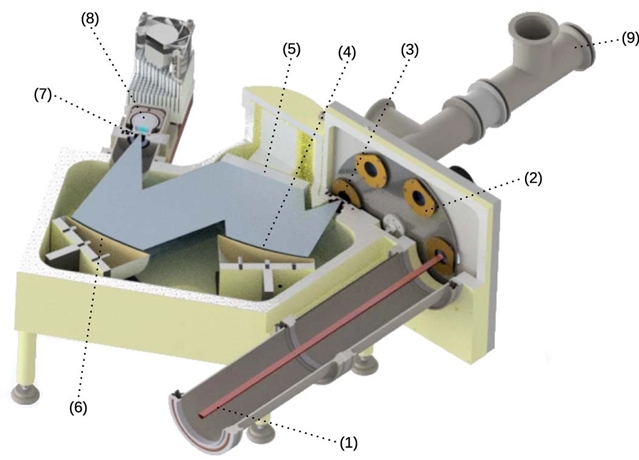
近日,比利时鲁汶大学的Sandro Kraemer及其研究小组取得一项新进展。经过不懈努力,他们成功观察到了229Th核钟同分异构体的辐射衰变。相关研究成果已于2023年5月24日在国际权威学术期刊《自然》上发表。
该研究小组报道了钍-229(229mTh)中低能异构体的辐射衰变的探测结果。通过在CERN的ISOLDE设施中将229mTh嵌入到大带隙的CaF2和MgF2晶体中,并进行真空紫外光谱测量,测得了8.338(24)eV的光子能量,与最近的测量结果一致,并将不确定性降低了七倍。研究人员确定了嵌入在MgF2中的229mTh的半衰期为670(102)秒。该研究观测到的大带隙晶体中的辐射衰变对于未来核钟的设计具有重要意义,同时改善能量的不确定性有助于探索直接激光激发原子核的方法。
据悉,钍-229放射性核素具有一种异常低激发能量的同分异构体,使得人们可以直接通过激光操纵核态。它是在下一代光学钟中使用的主要候选之一,将成为精确测试基本物理的独特工具。尽管关于这种非平凡核态的间接实验证据相当古老,但直到最近才通过观察同分异构体的电子转换衰变进行了证实。研究人员已经测量了同分异构体的激发能量、核自旋、电磁矩、电子转换寿命以及更精确的同质异构体能量。尽管取得了近年的进展,但同质异构体的辐射衰变(对于核钟的发展至关重要)尚未被观测到。
附:英文原文
Title: Observation of the radiative decay of the 229Th nuclear clock isomer
Author: Kraemer, Sandro, Moens, Janni, Athanasakis-Kaklamanakis, Michail, Bara, Silvia, Beeks, Kjeld, Chhetri, Premaditya, Chrysalidis, Katerina, Claessens, Arno, Cocolios, Thomas E., Correia, Joo G. M., Witte, Hilde De, Ferrer, Rafael, Geldhof, Sarina, Heinke, Reinhard, Hosseini, Niyusha, Huyse, Mark, Kster, Ulli, Kudryavtsev, Yuri, Laatiaoui, Mustapha, Lica, Razvan, Magchiels, Goele, Manea, Vladimir, Merckling, Clement, Pereira, Lino M. C., Raeder, Sebastian, Schumm, Thorsten, Sels, Simon, Thirolf, Peter G., Tunhuma, Shandirai Malven, Van Den Bergh, Paul, Van Duppen, Piet, Vantomme, Andr, Verlinde, Matthias, Villarreal, Renan, Wahl, Ulrich
Issue&Volume: 2023-05-24
Abstract: The radionuclide thorium-229 features an isomer with an exceptionally low excitation energy that enables direct laser manipulation of nuclear states. It constitutes one of the leading candidates for use in next-generation optical clocks1,2,3. This nuclear clock will be a unique tool for precise tests of fundamental physics4,5,6,7,8,9. Whereas indirect experimental evidence for the existence of such an extraordinary nuclear state is substantially older10, the proof of existence has been delivered only recently by observing the isomer’s electron conversion decay11. The isomer’s excitation energy, nuclear spin and electromagnetic moments, the electron conversion lifetime and a refined energy of the isomer have been measured12,13,14,15,16. In spite of recent progress, the isomer’s radiative decay, a key ingredient for the development of a nuclear clock, remained unobserved. Here, we report the detection of the radiative decay of this low-energy isomer in thorium-229 (229mTh). By performing vacuum-ultraviolet spectroscopy of 229mTh incorporated into large-bandgap CaF2 and MgF2 crystals at the ISOLDE facility at CERN, photons of 8.338(24)eV are measured, in agreement with recent measurements14,15,16 and the uncertainty is decreased by a factor of seven. The half-life of 229mTh embedded in MgF2 is determined to be 670(102)s. The observation of the radiative decay in a large-bandgap crystal has important consequences for the design of a future nuclear clock and the improved uncertainty of the energy eases the search for direct laser excitation of the atomic nucleus.
DOI: 10.1038/s41586-023-05894-z
Source: https://www.nature.com/articles/s41586-023-05894-z
Nature:《自然》,创刊于1869年。隶属于施普林格·自然出版集团,最新IF:69.504
官方网址:http://www.nature.com/
投稿链接:http://www.nature.com/authors/submit_manuscript.html
